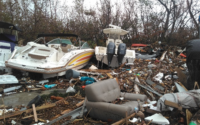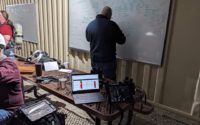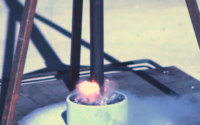Adsorption vs Absorption
Tyler Broughton
Unconventional thinking for the fire service instructor

This article is going to be a collection of my thoughts pertaining to building relationships as an educator with a focus on the fire service. I always think about the terms “adsorption” and “absorption”. They have always stood out to me as such a finite way to describe two diverse ways of doing a job in such separate ways. At the time of writing, my team and I are midway through a Hazmat Tech class here in Oklahoma. Our Hazmat Technician Class is 80 hours – two weeks of instruction and a half day of testing. The certification testing will cover ICS paperwork, a written test, and a skills portion. I have been an instructor for Oklahoma State University for 10 years and I have seen the testing process and class syllabus change multiple times over the years. The classes I instruct vary from hazmat awareness (8 hours), hazmat operations (40 hours), hazmat technician (80 hours) and hazmat technician and operation refreshers. I also instruct on the industrial side, doing hazwoper classes and refreshers for different entities. I say all that because I run into many diverse types of responders and individuals at a lot of various levels. As instructors, we find ways to adapt to the changes. Our goal is to educate, so we change our production and delivery until the material seems right. But who is it right for?

I believe one of the most underutilized parts of human interaction is the very first connection. The students in class have a perception of what is expected of them and the instructors from outside sources, no matter the class or the level of class. You want your class to want to be there, and this is great if it was a class they signed up for on goodwill and not a refresher of some sort. At the start of each new class, our audience always gets my attention. I start wondering about where these people are from – not just their department, name, and rank. A good friend of mine I work with started with this opening question: “What did you do before the fire service?” Such a simple question, but it opens doors to human interaction. After seeing this several times, I thought to myself, it is important to see the person behind the uniform. I want you to be thinking of your situation and your program as you continue reading these thoughts!
Our audience is always different in a couple of separate ways on a simple level: different jobs, different departments, different careers. On a more complex level, what will they be doing when they leave this class? For example, we teach responders on an industrial fire brigade who respond to a list of known chemicals, to the police officers getting a prerequisite for bomb school, and to everyone in between. The concepts and scenarios we deliver in class are important to them, but are especially important to the instructor! I want you to think at a post-class level, most of our students will never be involved in the situations we present to them. Building blocks are important for developing a structured hazmat program that’s also fluid enough to withstand the changes and challenges you and your department have.
Somewhere along the way, hazmat became the backseat passenger in the fire service, even on the way to a hazmat scene. In Oklahoma we have a regional response system made up of 8 regions. Of those 8 regions, 5 have a hazardous materials unit on an actual fully equipped hazmat-dedicated response truck.
That said, many of our people leaving class will be on a first due engine, not a hazmat rig. So, after spending 80 hours in our class what can they take away? What changes for them? That is a question for you to find out in your program. I believe we find these things through conversations at the personal level once again at the very beginning of a class. As you know, teaching comes with many challenges! If you are still reading, I hope you are asking yourself many questions about your program and delivery!
I think most would agree that we teach from experience, whether from personal experience or something you heard someone say at some time, but even that has an expiration date that we must account for. I believe we should also teach from a relationship perspective. What does that mean? We need to take the time to get to know the people in our class. What drives them? Why are they here? What is their motivation? When we take the time to learn the answers to these questions, we can focus our material on the students and have some fluidity.
We all know the difference between adsorption and absorption. In the classroom setting, we are normally dealing with people who are adsorbing information. They are adhering to the information and protocols we are laying out before them because they need to know the material to pass a test. They may or may not feel the information applies to them, but it will “stick” with them long enough to get through the next few days of class time so they can get back to their normal routine. To absorb the information means that what we are teaching them is really sinking in. They can relate to it. They understand the scenarios and the techniques, they can relate it to real-life situations and experiences. Our goal is absorption, and as in any situation, absorption is only possible when we know what/who we are dealing with. Relationships are key to absorbing information. I believe that strong relationships between instructors and students can dramatically enhance students’ level of motivation and promote learning.
My question for you is how do you build that relationship? It could be a simple conversation. Finally, I want you to think about progressing your program the best way you can, and I hope you think about the terms “adsorption” and “absorption” during your next class.



